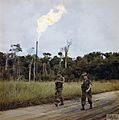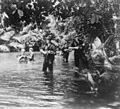Queen's Own Highlanders (Seaforth and Camerons) facts for kids
Quick facts for kids Queen's Own Highlanders(Seaforth and Camerons) |
|
|---|---|
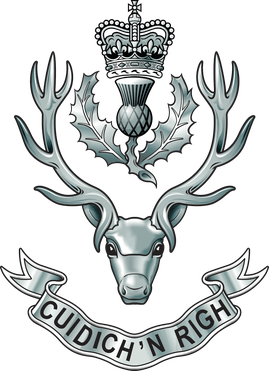
Cap badge of the Queen's Own Highlanders
|
|
| Active | 1961–1994 |
| Country | |
| Branch | |
| Type | Line Infantry |
| Role | Armoured infantry latterly. Originally Light infantry |
| Size | One Battalion |
| Part of | Scottish Division |
| Garrison/HQ | Dreghorn Barracks, Edinburgh originally Fort George |
| Nickname(s) | The Blue Mafia |
| Motto(s) | Cuidich 'n Righ (Help the King) |
| Colors | Blue and Buff Facings. |
| March | Quick: Pibroch o Donal Dubh/March of the Cameron Men/Cabarfeidh (Also a Military Band/Pipes called Queen's Own Highlanders used to march off) |
| Mascot(s) | The informal regimental nickname of the stags head cap badge was "Hector". |
| Engagements |
|
| Commanders | |
| Colonel-in-Chief | The Duke of Edinburgh |
| Insignia | |
| Tartan | 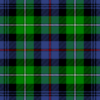 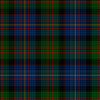 Kilt: Mackenzie, (Seaforth), (left) Trews: Cameron of Erracht, (right) Reverse: for pipers, drummers and band members |
The Queen's Own Highlanders (Seaforth and Camerons) was a famous infantry (foot soldier) group in the British Army. It was also known as "QO HLDRS" for short. This regiment was part of the Scottish Division and existed from 1961 to 1994.
Contents
History of the Queen's Own Highlanders
Forming the Regiment (1961-1970)
The Queen's Own Highlanders regiment was created on February 7, 1961. This happened at Redford Barracks in Edinburgh. It was formed by joining two older groups: the 1st Battalion, Seaforth Highlanders and the 1st Battalion, Queen's Own Cameron Highlanders. This change was part of a bigger plan to make the British Army smaller. The plan was announced in 1957. It aimed to reduce the number of soldiers after the end of National Service (when people had to join the army).
In April 1961, the new battalion (a group of soldiers) was sent to Singapore. From there, they went to Brunei in December 1962. Their job was to help stop the Brunei Revolt, which was part of the Indonesia–Malaysia confrontation. They successfully took back the Shell oilfields at Seria from rebels. They also freed 48 people who were being held hostage.
After returning to Singapore in February 1962, the battalion went back to Borneo three months later. They spent their time on long patrols and guarding areas near the border with Indonesia.
In January 1964, the battalion returned to Scotland. They were based at Milton Bridge Camp. In June 1964, they moved to Germany, joining the British Army of the Rhine. They stayed there until August 1966, then moved to Berlin. In September 1968, they returned to Redford Barracks in Scotland. From there, some soldiers went to Sharjah in the Persian Gulf in May 1969. In July 1970, they performed ceremonial duties at the Commonwealth Games in Edinburgh.
Challenges and Peacekeeping (1971-1982)
In April 1971, the battalion went back to Germany. From there, they were sent to Northern Ireland three times. These were four-month missions during a difficult time called the Troubles. They served in East Belfast (November 1971 – March 1972), Dungannon (July – October 1972), and West Belfast (December 1973 – April 1974).
In June 1976, the battalion returned to Scotland. From their base, parts of the group were sent to Belize and Gibraltar. They also went to Northern Ireland two more times. These tours were in North Armagh (April – August 1978) and South Armagh (July – December 1979). During the 1979 tour, their commanding officer, Lieutenant-Colonel David Blair, was sadly killed. He died in an incident where bombs exploded by the road. Seven Queen's Own Highlanders soldiers lost their lives in Northern Ireland between 1973 and 1990.
In March 1980, the battalion was sent to Stanley Fort in Hong Kong. They then moved to Tidworth in England in November 1981. Even though they were the Army's "Spearhead" battalion (ready for quick action), they did not fight in the Falklands War that started in April 1982. However, they were sent to the Falkland Islands right after the fighting stopped. They helped bring things back to normal from July to December 1982. For this important work, the regiment received the Wilkinson Sword of Peace. This award is given to the British Army unit that helps community relations the most each year.
Later Years and Amalgamation (1983-1994)
In November 1983, the battalion moved to Aldergrove in Northern Ireland. They stayed there as the local resident battalion. Then, in November 1985, they moved to Fort George in Scotland.
In March 1988, the battalion moved to Germany. From there, they were sent to Northern Ireland again for five months in March 1990. In January 1991, they went to Saudi Arabia to take part in the Gulf War. During this war, the battalion was split up to help other army groups. Sadly, three Queen's Own Highlanders soldiers were among eleven soldiers who died in a friendly fire incident. This happened when two US aircraft accidentally bombed a UK armoured column.
After the war, the battalion returned to Germany. They had one more six-month mission to Northern Ireland from November 1992. The battalion finally returned to Scotland in October 1993. They moved into Dreghorn Barracks, near Edinburgh.
Due to a defence review called "Options for Change," the battalion was joined with another group. On September 17, 1994, they combined with the 1st Battalion, Gordon Highlanders. Together, they formed the 1st Battalion, Highlanders (Seaforth, Gordons and Camerons). There was a big effort to stop this merger, but it did not succeed.
Territorial Army and Cadet Force
After the Queen's Own Highlanders were formed in 1961, the part-time army groups continued. These were the 11th battalion, Seaforth Highlanders (TA) and the 4/5 battalion Cameron Highlanders (TA). In April 1967, both were disbanded. A new group, the 3rd (Territorial) battalion, Queen's Own Highlanders, was formed. However, this group was also disbanded in March 1969. After that, all part-time Highland soldiers became part of the 51st Highland Volunteers.
The Army Cadet Force (ACF) units in northern Scotland kept the names and badges of the Seaforth and Cameron Highlanders until 1968. Then, they became the North Highland ACF and used the Queen's Own Highlanders badge. In 1975, they became the 1st Cadet Battalion Queen's Own Highlanders ACF. In April 1982, they were renamed the Queen's Own Highlanders Battalion ACF. In September 1999, this battalion changed its badge and name again. It became the 1st Battalion The Highlanders, Army Cadet Force.
Regimental Museum
The Highlanders' Museum (Queen's Own Highlanders Collection) is located at Fort George. This museum is near Inverness, Scotland.
Regimental Tartans
The regiment wore two main tartan patterns:
- The Mackenzie tartan kilt, which was worn by the old Seaforth Highlanders.
- The Cameron of Erracht tartan trews (trousers).
- Pipers, drummers, and band members wore the reverse of these tartans.
Important Leaders
Colonel-in-Chief
- 1961–1994: F.M. The Prince Philip, Duke of Edinburgh, KG, KT, OM, GBE, AC, QSO
Regimental Colonels
These were the main leaders of the regiment:
- 1961–1966: F.M. Sir Archibald James Halkett Cassels
- 1966–1975: Gen. Sir Peter Mervyn Hunt
- 1975–1983: Lt-Gen. Sir Chandos Blair
- 1983–1994: Maj-Gen. John Charles Oswald Rooke Hopkinson
In 1994, the regiment joined with The Gordon Highlanders to form The Highlanders (Seaforth, Gordons and Camerons).
Images for kids
-
Queen's Own Highlanders on guard at the Seria oilfield, during the Brunei revolt, December 1962
-
Troops from the Queen's Own Highlanders searching for enemies during a patrol in 1963 during the Indonesia–Malaysia confrontation


